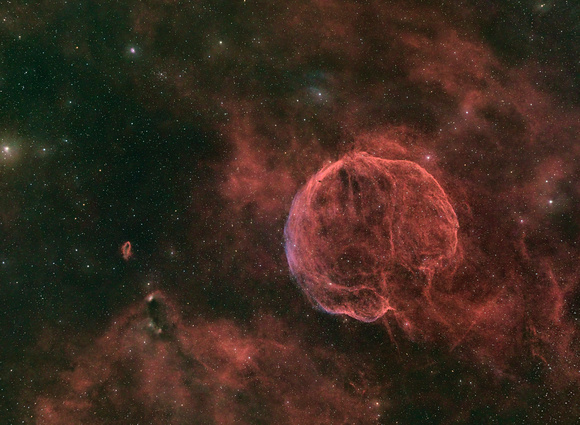CTB-1, Abell 85, LDN 571, The Medulla Supernova Remnant in RGBHO
CTB1 – Abell 85 – LBN 576 – Medula Supernova Remnant in RGBHO (Cassiopeia)
Televue 127is; AP Mach2 GTO
ASI6200MM, - Baader RGB & 6.5nm NB CMOS opt. filters
Ha,OIII: (28,36 x 660s exposures, Bin 1x1, Gain 100)
R,G,B: (20,19,25 x 180s, Bin 1x1, Gain 100)
Total Integration Time = 14.9 hours
Initially I believed Abell 85 to be a nice large, although quite dim, planetary nebula that I would be able to capture with my 5” refractor. As it turns out, it isn’t a planetary nebula at all (as would be suggested by its inclusion in the Abell catalogue), but a super-nova remnant (SNR). To me, it is obviously not a PN, but if I were to guess, I would have thought it was a Wolf-Rayett sinice its structural similarities are more akin to the Crescent Nebula rather than the Cygnus Loop or M1. It has the same “dual shell” feature of the Ha signal within an [OIII] (or [O++]) bubble. However, it is hard to identify a WR candidate star within the Nebula. That, and the nature of a radio signal from the object led to the reclassification from Planetary Nebula to SNR by the astronomy gods in 1972.
The common name for this object is the “Medulla Nebula”, and this is somewhat apt as the nebula looks very similar to the brain and top part of the spinal cord. Technically, the Medulla Oblongata is only the part that connects the two, but hey – it still sounds good and more apt than it’s other common name the “Popped Balloon Nebula”. The supernova was thought to have taken place 10,000 years ago, According to a description in “Sky and Telescope”, it is “approximately” 9,780 light years away and spans “approximately” 98 light years in diameter (50 light year radius). (I put approximately in quotes, because one shouldn’t preface precise numbers with approximately). In any event, I will use the numbers to say that it took 220 years to grow that size from a point source super-nova. This means that the shell would be expanding at approximately 25% the speed of light. Seems speedy, but I have no idea if this is realistic.
While I was warned that this object was dim, the oxygen signal was extremely dim. When I started to process I determined that I would need more frames with my oxygen filter, which I forged ahead and obtained. However, I later realized that between getting my initial and additional frames, I had installed a field flattener on my telescope to correct my misshapened corner stars from my full-frame camera. As I found out, this creates a disaster when you try and combine the frames because the corner stars are in very different positions. As a result, I had to crop back this image fairly heavily to where the stars could be correctly aligned.
Apart from the SNR, there are a few smaller interesting objects in this frame, including what looks like a dark cloud nodule that is lit from the far side, a very faintly outlined dark cloud pillar containing two infant stars reflecting near its tip, and an interesting open cluster – likely the result of a long dispersed molecular cloud / nodule.
Thanks to the script by Cranfield and Blanshan on star reduction to help reduce the stars in a controlled manner.


